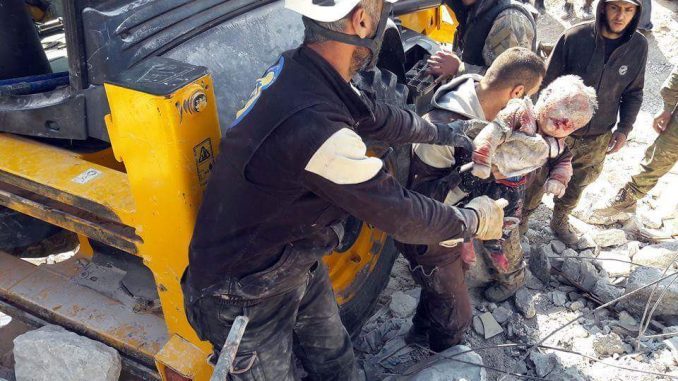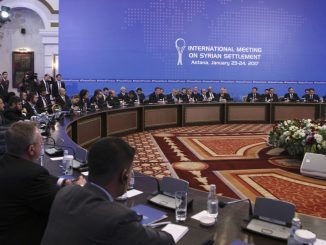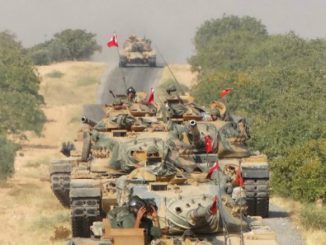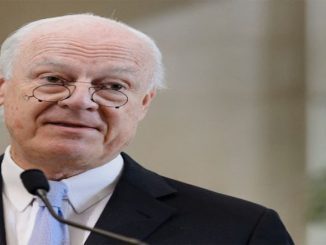
Assad regime jets bombed a rebel-held district of Homs city killing several people. two days after a similar incident in Idlib, in a clear breach of the truce and escalation before the upcoming peace talks in Geneva.
At least eight people killed in airstrikes on the rebel-held al-Waer neighborhood of Homs, the Syrian Observatory for Human Rights said, in a clear breach of the truce agreement.
The truce was agreed on 22 December 2015, and reassured in the peace talks meeting in Astana when Russia, Turkey and Iran said they will be guarantees of it to prepare a suitable environment for a political solution.
However, the repeated breaches in Homs and Idlib give a direct indication about Assad regime’s disrespect for these agreements.
The Syrian Civil Defence, a rescue service operating in rebel-held territory, did not give a figure, but said on its Facebook page that its centre in al-Waer was hit, wounding a staff member, and that there were fatalities elsewhere including women and children.
“Yesterday it suddenly escalated,” he told Reuters news agency.
A military media unit run by Assad’s Lebanese ally, Hezbollah, said the army had fired rockets and that planes had carried out three strikes against rebels in al-Waer, who it said had violated a shaky ceasefire across parts of western Syria.
Al-Waer has for months been spared the intense bombardment by Syrian and Russian air forces, but the resumption of it may be an indication to the regime’s dedication to end the district’s issue.
Assad regime has tried to conclude a deal in al-Waer that would see rebel fighters and their families evacuate the district and the regime take over. Under similar local agreements in other parts of western Syria, rebels have left with light weapons and headed mostly for Idlib.
Assad said on Wednesday that local reconciliation agreements were the “most effective way to end the war and move towards a political solution,” state news agency SANA reported.
In September some 120 rebel fighters and their families left al-Waer in agreement with the regime, but there have been no further reports of insurgents leaving the area. The Observatory estimates several thousand rebels remain in the district.
The opposition says such agreements are part of the regime’s strategy “surrender or die” aiming at forcibly displacing populations from opposition-held areas after years of siege and bombardment, and gathering them in one place, preparing for a final blow against the rebels and the revolution.
Airstrikes on Idlib
The Syrian Observatory for Human Rights said on Tuesday that at least 26 people were killed and casualties were expected to rise as rescue workers searched for bodies under the rubble.
“Ten civilians, mostly women, are among the dead,” Rami Abdel Rahman, head of the monitoring group told AFP news agency.
The strikes also wounded scores of people and levelled several multi-storey buildings in residential areas of the northwestern city, according to witnesses, who told Reuters news agency that the extent of the damage and the debris bore the hallmarks of a Russian attack.
The Civil Defence, a volunteer rescue group operating in rebel-held areas, gave a different death toll, saying 15 bodies were pulled from the rubble and that 30 wounded people were taken for treatment.
Video footage by activists on social media showed civilians, including young children, being treated in a main city hospital where the injured had been taken for treatment.
Russian planes have targeted a number of towns and villages in the area since entering the Syrian conflict in September 2015 to back ally President Bashar al-Assad.
Most recently, At least 73 people have been killed in suspected Russian air strikes on several areas of Idlib province in December marking the highest death toll in long months of massacres.
Idlib, the next aim
By the summer of 2015, President Assad seemed on the verge of being overthrown. Then Russia launched its military intervention – all the while paying lip service to a diplomatic process the US administration pursued to no avail.
The Russian intervention tilted the war in favor of Assad regime and cost the rebels many of their strongholds, making Idlib among the last important pressure point on Assad regime to accept a political solution to end the war.
The Assad regime forces, backed by Russian air power, Iranian ground forces and Shi’ite militia fighters from Iran, Iraq, and Lebanon, has been tightening its grip on rebel-held districts of Aleppo and Idlib since the start of this year, and were able in the end to retrieve Aleppo after months of fighting.
More than 40.000 civilians were displaced from Aleppo and sent to Idlib province.
After Aleppo, Idlib will be the next aim, and Assad regime has already started to prepare for the battle with daily bombing and massacres since months. The number of deaths rose sharply in October.
Idlib province is witnessing massacres and random killing by regime and Russian warplanes and Helicopters using missiles, barrel bombs and heavy machine guns, the heavy bombardment started in the 20th of October leading to massive raise in the dead numbers, according to the observatory.
SOHR documented the death of 288 civilians including 93 children and 55 women in the period between 22nd of October until today, by aerial bombardment by Russian and Syrian warplanes, while 1000 others were wounded and seriously wounded or permanently wounded, in addition to massive material damages.
In November, Defence Minister Sergei Shoigu said Russian forces had begun a “major operation” targeting Idlib and Homs provinces.
According to analysts, the regime is trying to gather the rebels in Idlib, making it easy to fight them all fiercely in one place under the term of fighting terrorism. The fierce campaign may take long, but analysts say it will succeed eventually as happened in Aleppo if the global powers didn’t take any real steps to stop it.



